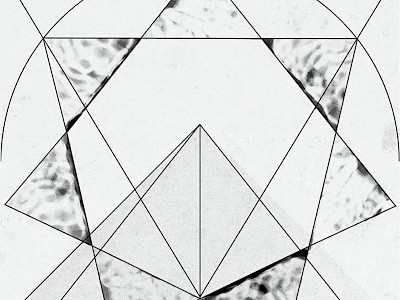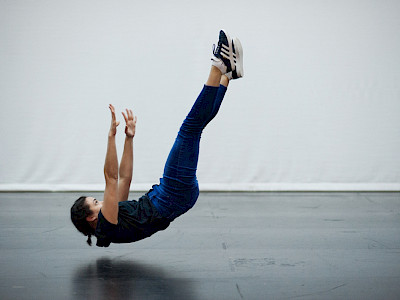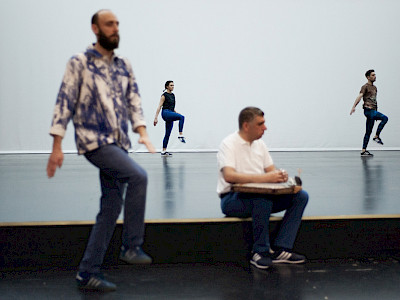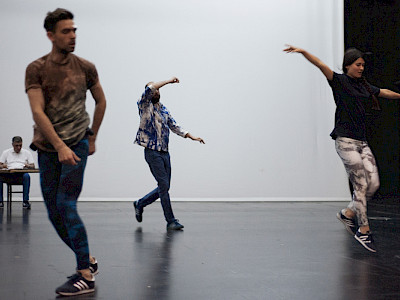17 — 20.05.2017
Each era has its wonders of the world, the idea of an impossibility that is nevertheless constructed, bigger and more impressive that anything the world has known. These architectural and artistic tours de force mark the victory of man over his physical limits and the laws of nature. But isn’t the human body that has devised and made these imposing wonders even more wondrous? Isn’t it more mysterious and more beautiful that the giants we are surrounding ourselves by? This latest work by the Moroccan dancer and choreographer Radouan Mriziga brings a trilogy to a close. The first part of the trilogy, ~55, was performed at the festival in 2015. Once again, the relationship between dance, construction and architecture is at the heart of his work. In a precise and refined choreography, Mriziga confronts the beauty of the moving body with the geometric power of architecture and sculpture. 7 heads off on a quest for the world’s ultimate miracle: the human body.
“I’m interested in buildings and in the use of space”
Choreographer and dancer Radouan Mriziga studied dance in Marrakesh and Tunis before continuing his training at P.A.R.T.S. in Brussels. Interested in the relationship between the body and its surroundings, it is architecture that provides the common thread in his work. “The important thing for me is to have the freedom to be able to present my work in different contexts and to be surprised at how the context can add something to the work.” A conversation with Radouan Mriziga by Esther Severi.
How did you start with dance and how did it bring you from Morocco to Brussels?
My interest in dance happened quite organically, although I grew up in a context where contemporary dance wasn’t a given. I’ve always done a lot of bodily activities, though: different sports, and street-dance. At first, dance was more of a general interest, but very soon I wanted to develop dance as a daily practice. In Morocco, however, there wasn’t a dance scene – no fundamental support or schools – so I had to find my own way to practice it. At a certain moment, I met two artists who were to become my first real mentors, Jacques Garros and Jean Masse. They gave a workshop in Meknes (Morocco) and inspired me to apply to a dance school in Tunisia. There, I was taught an emphasis on bodywork as well as offered a scientific insight into anatomy. This had a lot of impact on my artistic education. After Tunisia, I went to France to study with Jacques and Jean once again, but afterwards felt I needed other input. I heard about P.A.R.T.S., so I applied there and then came to Brussels. What attracted me to it, apart from the technical dance training, was the emphasis on choreography and performance and on a different way of dealing with theory than what I had encountered in previous schools. At P.A.R.T.S., the idea of theory was very open and wide; it became a possible source for performance. The combination of different types of training has worked well for me – I never liked the idea of being stuck in one vision. Each of the places pushed me to the next, in that I felt I had to react to something specific, to search further, to find a different way of thinking.
Your development as a dancer has brought you to a different continent. How do you give shape to the distance between your place of origin and your current living context?
I really enjoy living and working here in Brussels, but since graduating from P.A.R.T.S. I’ve felt the need to work and perform elsewhere as well, not just in Europe. My cultural background is partly where my interests and inspirations come from, so I need to stay close to that. Currently, there are actually more possibilities to work with dance in Morocco. I’m developing a good network and am working on different projects. One of these is an artistic and educational project founded by Meryem Jazouli in Casablanca. The goal is for choreographers to work with young Moroccan dancers. We started with a workshop, from which I selected two dancers. I then went on to develop a performance with them. The trajectory of this creation is much longer than normal because the work is going much more slowly. These dancers are not students anymore, yet they didn’t receive the professional training that dancers in Europe get. The idea of this project is that the dancers can work and learn at the same time. In general, there are important developments going on in the field of dance in Morocco. In 2016, I performed a short piece at the opening of the Marrakesh Biennale, which is quite a big event, broadcast live on television nationwide and watched by a lot of people. It has been a clear and important decision to have a contemporary dance piece at the opening, in front of so many eyes. This indicates that there is an openness and that the face of dance is changing, which will hopefully create different conditions for young Moroccan dancers in the near future.
What are the interests and inspirations you refer to? Are there key principles in your artistic work that resonate through every creation?
An important question for me is: what can I do with dance and choreography as tools to reach outside of dance and choreography as disciplines. I’m interested in exploring the knowledge of the body and of movement, to produce new things and to relate differently to the surroundings. This question has been present since the beginning of my artistic practice. And the other layers have been added organically. For example, I started to be interested in building and construction as actions, which brought me to researching architecture and mathematics. In Arabic architecture, mathematics plays quite a symbolic role. From there, I started developing ideas about the relationship between mind, body, and spirit, which then became an essential part of all my artistic work.
At Kaaitheater, you presented a solo, 55 (2014) and a quartet, 3600 (2015), which formed the first and second part of a trilogy. In May, during the Kunstenfestivaldesarts, you will present the final part, 7. What have you researched for these works, and why do they come in the form of a trilogy?
The trilogy format enables me to research a specific theme more deeply and to underline the continuity in the work. The overall subject matter is the connection between the moving body and the construction and expression of architectural and sculptural forms in relation to the idea of craftsmanship. I started with a solo, 55, in which I used my own (moving) body as a tool to create a structure, which became a drawing on the floor. Following this work, I wanted to collaborate with a group so that I could see the research resonate in the bodies of others and step out of the process, in order to look at it from a distance. In 3600, along with three dancers, I started to build actual structures with bricks, to explore the movements and rhythms of construction as opposed to the movement that inhabits these structures. The title of the last part, 7, refers to the idea of the seven wonders of the ancient world. There will be six or seven performers on stage, so the scale will increase again. The work will concentrate on the idea of a wonder, a structure that is ‘larger than life’, or a fantasy, in relation to the human body that has stayed the same throughout history – an incredible and mysterious wonder in itself!
You mention craftsmanship – how does this idea appear in your performances thematically, and what is the relationship of this topic to your own practice as a dancer/choreographer?
The notion of craftsmanship was already there in 55 and 3600, but more as a hidden layer. In 7, it becomes very important and dominant. I realised that the connection between dance, construction, and architecture lies precisely in this idea of crafting. I increasingly focus specifically on why it matters to do things with our hands and bodies and to make things exist in this way. I often speak of a dance, a choreography, or a performance as an object, because I consider it to be something ‘crafted’, bodily. And craft, for me, is also related to time. In dance, or in performance in general, the time it takes to actually make something is a time shared between dancers and the audience. Maybe that is what remains of craftsmanship in our era, a direct and witnessed ‘crafting’, and in this way, a true understanding of effort and skill…
You present your work in different contexts – performing arts as well as visual arts. Do you have a specific desire to be active in the field of visual arts and to escape the black box of the theatre?
The black box is a very important space for me – a space I want to question by going out and in again. I’m interested in exploring the differences in performing inside and outside. The black box is a smart space, with a perspective and with machinery that influences or directs the views. As soon as you step out, this changes completely. The tension between these different modes is something I take with me in the creation process. For instance, I consciously made 55 flexible. When I was creating this piece in the black box, I was already imagining other presentation contexts – locations outside of the black box, and not only in Europe. I made it flexible so that it can easily travel and adapt to different situations. Scenographer Jozef Wouters said something very interesting about my work: that the objects I make with dance are always centred and are unrelated to the walls or the edges of the theatre space. I think I do this in order not to feel fixed in a space; to transport the idea of flexibility into the nature of the work. Now, for the new creation, 7, this will become an important question – how to increase the scale but keep the dynamic of flexibility… I don’t look for specific fields to perform in. The important thing for me is to have the freedom to be able to present my work in different contexts and to be surprised at how the context can add something to the work. As an example, we just presented 3600 in the Leopold Museum in Vienna. The surroundings, or architecture, that we performed within resonated strongly with the work, which keeps the work very much alive and dynamic.
Context, surroundings, and architecture are key words in your practice. Is the city of Brussels, in that sense, also a source of inspiration?
I’m interested in buildings and in the use of space, so of course the city where I live has an impact on my reflections. I see a curious parallel between Marrakesh, where I grew up, and Brussels. In Marrakesh, much of the beauty of the city and the architecture are hidden. The façade of a building does not reveal or represent what is inside. Sometimes I feel the same way about Brussels. You have to look through the chaos, or even the ugliness, to see the beauty of it. I find that interesting and inspiring! Both cities are very easy for me to become part of. You can wander around and disappear; you can become part of the space itself.
Interview by Esther Severi, dramaturge at Kaaitheater
Concept & choreography
Radouan Mriziga
Performed by
Radouan Mriziga, Maïté Jeannolin, Zoltán Vakulya, Bruno Freire, Eleni-Ellada Damianou, Lana Schneider, Suhad Najm Abdullah
In collaboration with the visual artist
Lana Schneider
Music played by
Suhad Najm Abdullah
Costumes
Annabelle Locks
Dramaturgic advice
Esther Severi
Artistic advice
Alina Bilokon
Assistant
Sara Chéu
Thanks to
Jozef Wouters
Presentation
Kunstenfestivaldesarts, Kaaitheater
Production
Moussem Nomadic Arts Centre
Co-production
Kunstenfestivaldesarts, Kaaitheater (Brussels), Sharjah Art Foundation (Sharjah), C-mine cultuurcentrum Genk, Vooruit (Gent) & PACT Zollverein (Essen), in the context of the European Network DNA (Departures and Arrivals), co-funded by the Creative Europe Program of the European Union
In collaboration with
Kunstenwerkplaats Pianofabriek, Charleroi Danses – Centre Chorégraphique de la Fédération Wallonie-Bruxelles







